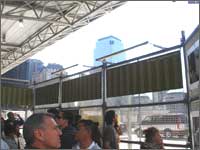Today's Notables
Overseas Report: Michigan, New York
June 2007
Hisashi Furuichi
President and C.E.O.
On my trip this time, I visited Michigan State University to check
on a Primix high-speed, thin-film mixer that is currently on loan
to the Materials Engineering Section in the Chemical Engineering
Department at the University, which was reported in an earlier shinko.
It has proven to be very useful even under changed conditions and
there has been absolutely no trouble with the machine since it was
installed six months ago. Asst. Professor Lee is heading up the
laboratory where they are currently addressing two major research
topics, one of which is processing of nanostructures and their application
in the field of biomimetic interface. "Biomimetics" is
a word not often heard although we are familiar with "bionics,"
which is derived from the combination of biology and electronics,
meaning the field of study of electrical engineering applications
in biological functions. An Indian doctoral student is using the
Primix T.K. FILMICS high-speed, thin-film, mixer on a daily basis
with the purpose of achieving their desired outcome. This particular
research determines whether he will be able to complete his doctorate
or not so he is very enthusiastic toward the research.
Another field of research is involves development of polymer film
or ointment that prevents to occurrence of wrinkles due to aging
of the skin. On January 25th the research was highlighted on Discovery
Channel (available in Japan on cable television) in the US, thus
catapulting Asst. Professor Lee into fame. They are currently purchasing
nano-size polymer that is being used in the research; however, Prof.
Lee projects that as research continues, he can use the T.K. FILMICS
to process the nano-structures from larger polymer particles. Other
laboratories have also requested the use of a T.K. FILMICS and with
laboratories at MSU fighting over the machine; it has been well
worth the efforts in installing it at the University. We are eagerly
looking forward to Asst. Professor Lee presenting his research at
the mixing technology seminar, Mixing Vision 2007, to be hosted
by Primix in December of this year.

After returning to Japan once, a group requested that I accompany them
to New York. New York still appears to be at the peak of a growth
period. Even studio apartments below a million dollars are hard
to find and I heard of a one room condominium selling for 48 million
dollars. I also heard that from 2000 to 2005, the number of Caucasian
children increased by 32% in Manhattan. Now Caucasian children between
the ages of 0 and 5 living in Manhattan account for 35% of the total
and it is the first time in the past 60 years that the numbers have
surpassed that of other nationalities (African Americans and Hispanics).
One of the reasons is the sudden emergence of a new white elite
class concentrated in American urban areas which seems to be driving
the recovery of many downtown centers and giving the growth traction.
Furthermore, the average household income of those Caucasian children
that are on the increase is 345,000 USD a year. Moreover, in the
US overall, a baby is born every 8 seconds while a person dies every
12 seconds. Another person immigrates to the US every 31 seconds
for an overall impact of an increase in population every 14 seconds
for a total population of 300,007,997 people.
Although the income gap in Japan is cause for concern,
there is no comparison with the income gap in countries like the US.
With the population in the US increasing and the labor force in Japan continuing to shrink,
I wonder if Japan can survive while remain internationally competitive
yet guarding against overwork of our workforce.
HOME > What’s New > Today's Notables > Details














